How to Add a Disclosure to Your WordPress Website (2026 Guide)

Did you know that failing to disclose paid partnerships or data collection could lead to penalties?
A website disclosure ensures compliance and builds user trust. Transparency isn’t just good practice these days—it’s the law.
As an affiliate blogger promoting affiliate links, a business mining customer data, or a brand working with influencers, having an overt disclosure statement on hand keeps you safe in court and keeps your audience in the loop.
From FTC disclosures to privacy disclosures, having the right information on hand means you’re trustworthy and committed to doing the right thing.
Let’s dive right into the topic.
What is a Disclosure?
A legal disclosure on a website is an official statement that provides important information about how the site works, what it is responsible for, and what users can expect.
This transparency helps the site comply with the law.
The disclosures protect both the website owner and the users by clarifying legal responsibilities and complying with laws like the GDPR, CCPA, or India’s Companies Act 2013. They also help prevent disputes.
You can usually find legal disclosures at the bottom of the website, on checkout pages, or next to related content to make them easy to see.
Types of Website Disclosures
Disclosures are important for helping users understand different aspects of a website, especially its goals, partnerships, and any possible conflicts of interest. Below are the main types of disclosures commonly found on websites:
1. Medical Disclaimer
Websites that provide health or legal advice must clearly state that their information is not a substitute for professional help. This disclosure helps users understand what the content is and protects the site from legal issues.
Example: A health blog may say that its information is for educational purposes only and advise users to seek guidance from a qualified professional for medical questions.
2. Third-Party Relationships
Disclosures about third-party relationships inform users about partnerships that may influence the content or services offered on the site. This includes relationships with advertisers or other organizations.
Example: An e-commerce site might disclose that it partners with certain brands and may receive payment for showcasing their products.
3. Affiliate Links
An affiliate disclosure is a statement that tells users that the website owner earns money by promoting products or services through affiliate links. This disclosure is important for being honest with the audience and following legal rules, especially those from the Federal Trade Commission (FTC) in the United States.
Example: A lifestyle blog might include a note saying that it earns a commission from purchases made through its affiliate links.
4. Advertisements
Advertising disclosures tell consumers when content is meant to be promotional. These notices make it clear that the material is an advertisement. This clarity helps build trust and transparency between advertisers and their audience.
Example: A personal finance site may state that while it has ads, it does not guarantee the products’ accuracy or reliability.
5. Testimonial
A testimonial disclosure is a statement that explains the circumstances surrounding a testimonial or endorsement. It helps the audience understand if the person giving the testimonial was paid, received free products or services, or has any other connection to the company that could influence their opinion.
6. Confidentiality
Confidentiality disclosure means sharing sensitive information and ensuring the person receiving it agrees to keep it private. This is often done through a confidentiality agreement or non-disclosure agreement (NDA). These agreements legally require both parties to protect the shared information from being accessed or used without permission.
It is important to adapt disclosures based on the specific services and information your website provides. This builds user trust and helps prevent potential legal issues by following regulations like those from the Federal Trade Commission (FTC).
By including clear and detailed disclosures, you create a more transparent online space that protects both your users and your business.
Why Adding a Website Disclosure is Important
In today’s digital landscape, building trust with your audience is just as crucial as delivering quality content. One of the most effective ways to do this is by including a website disclosure on your site.
Whether you’re sharing product reviews, promoting affiliate links, or collecting user data, a well-written disclosure statement ensures you’re being transparent and legally compliant.
1. Builds Trust and Transparency
Having a legal disclaimer notifies your users that you are honest about what you are doing. If you have an affiliate link on your blog, for example, an affiliate disclaimer notifies that you could be getting a commission at no cost to the user. This honesty will generate more trust and healthier relations with your visitors.
2. Ensures Website Conformity
Having a website disclosure also helps to keep websites in compliance with many regulations. Whether it’s an FTC disclosure for affiliate marketing or a privacy disclosure outlining how user data is collected and used, having these statements in place protects your business from potential legal issues.
3. Required by Law and Platforms
FTC instructs you to state clearly that you are paid or earning from links. Privacy regulations such as GDPR and CCPA also demand clear privacy disclosures.
Google’s Advertising & Disclosure Policies can also be consulted for further detailed information on how to correctly disclose promotional material.
4. Professionalism and Accountability
A comprehensive website disclosure reflects your commitment to truthful practices. It suggests you take your audience deeply into consideration and embrace responsibility for content and collaborations featured on your page.
How to Add a Disclosure to Your Website?
In this section, we will help you create a disclosure document for your WordPress website compliance using a legal document generator.
Using a plugin makes it easy to draft a disclosure statement for your website quickly.
We recommend the WP Legal Pages plugin a privacy policy generator to create a disclosure and other important legal pages for your site.
WP Legal Pages – A Legal Pages Generator Plugin

WP Legal Pages is a free tool that allows you to create and update your website’s disclosure pages easily.
You can quickly draft a disclosure that fits your business needs with ready-made templates.
WP Legal Pages offers over thirty-five pre-designed policy templates, allowing you to create various legal pages for your site.
The plugin includes templates for legal documents like refund policies, terms and conditions, privacy policies, disclaimers, and disclosures.
Now, let’s review the steps to create a affiliate disclosure document for your website.
Step 1: Installing WP Legal Pages Plugin
Navigate to your WordPress Dashboard and click on Plugins > Add New.
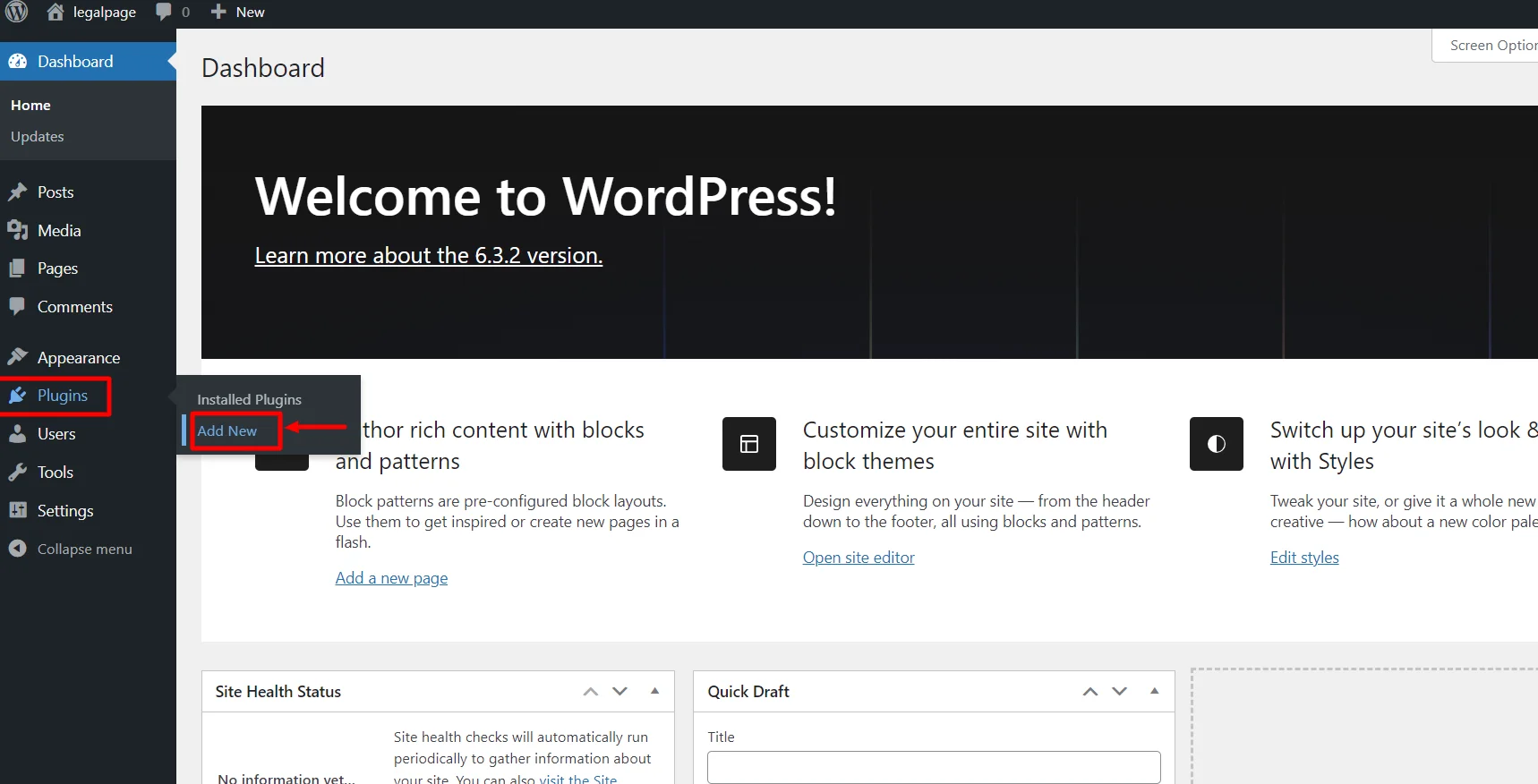
Search for WPLegalPages in the search bar.
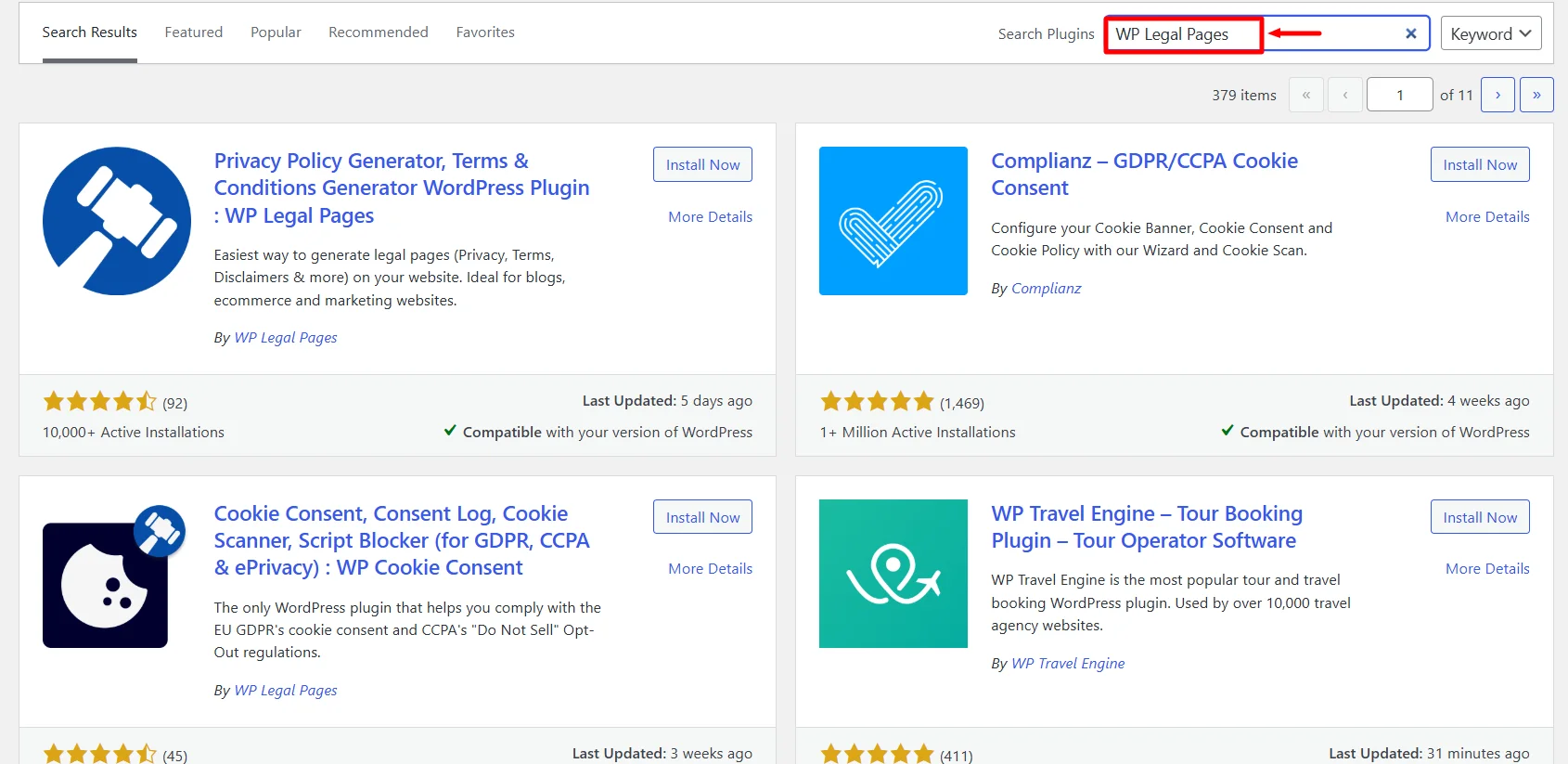
Click on the Install Now Button.
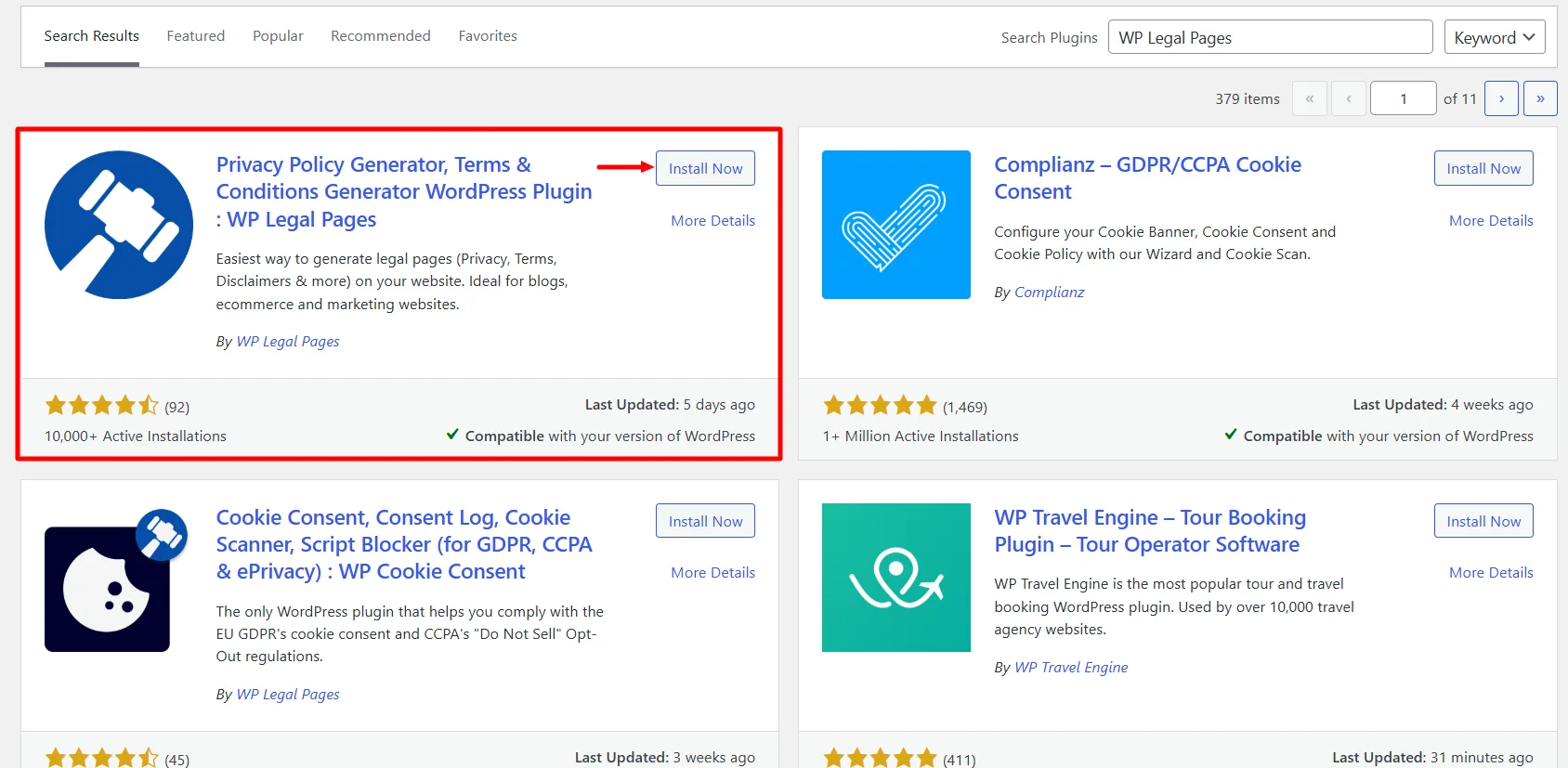
Activate the WP Legal Pages plugin by clicking the Activate button.
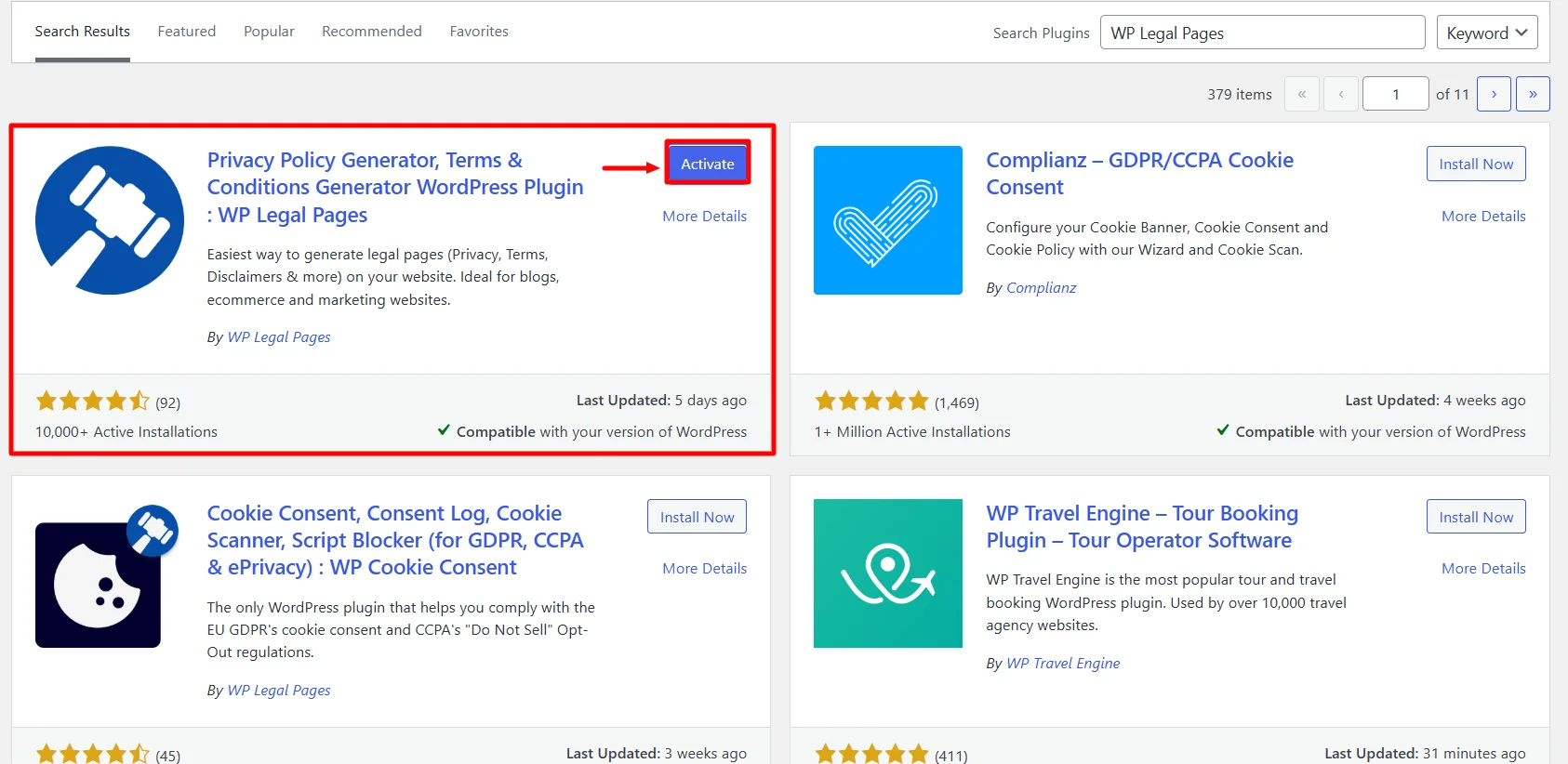
Step 2: Configuring WP Legal Pages Plugin
Once you have activated the plugin, you can access it directly from the Dashboard.
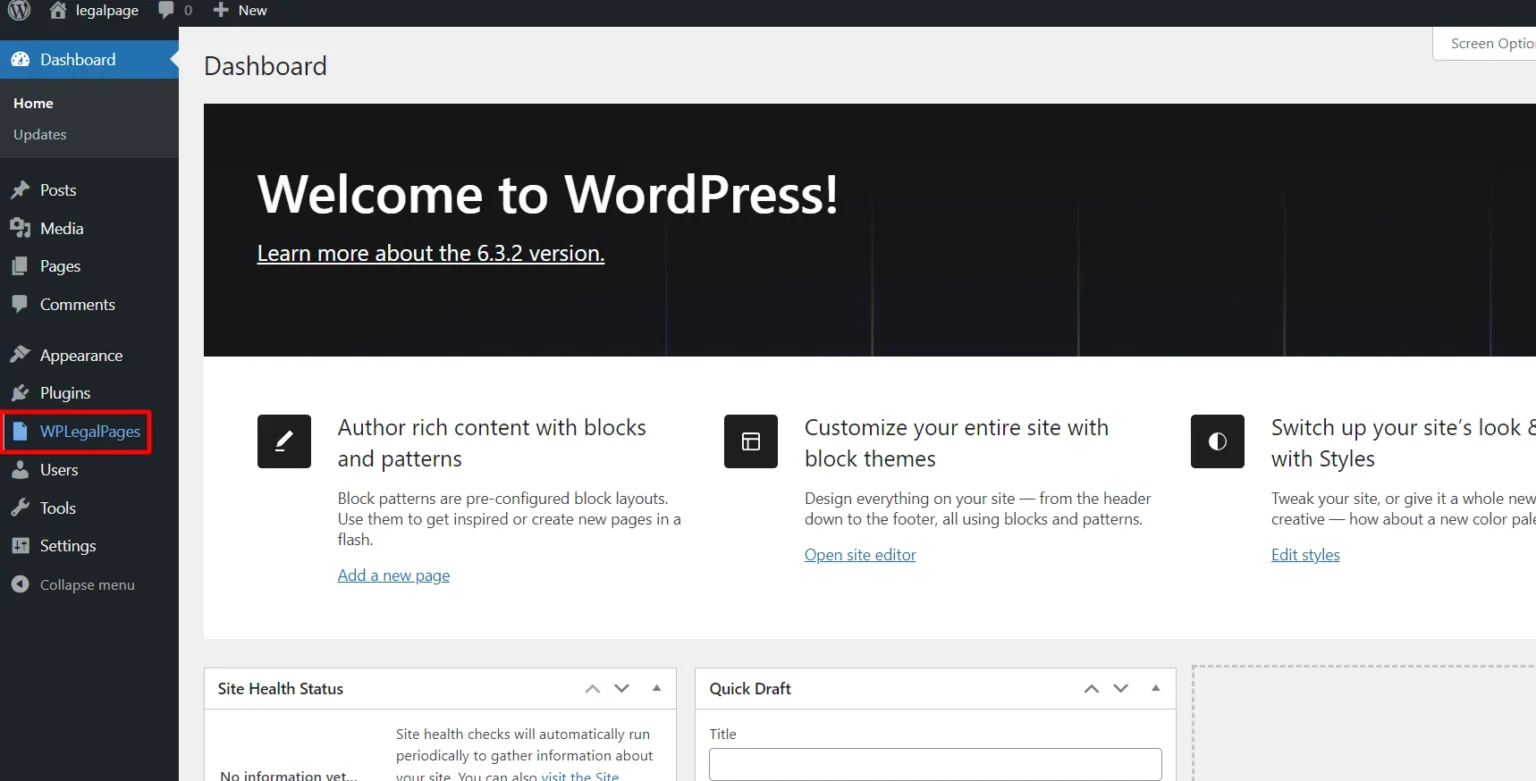
Next, accept the terms of use of the WPLegalPages plugin.

Step 3: Creating a Pro Account in WP Legal Pages
To generate legal pages for your website, scroll down from the dashboard and click Create Page.
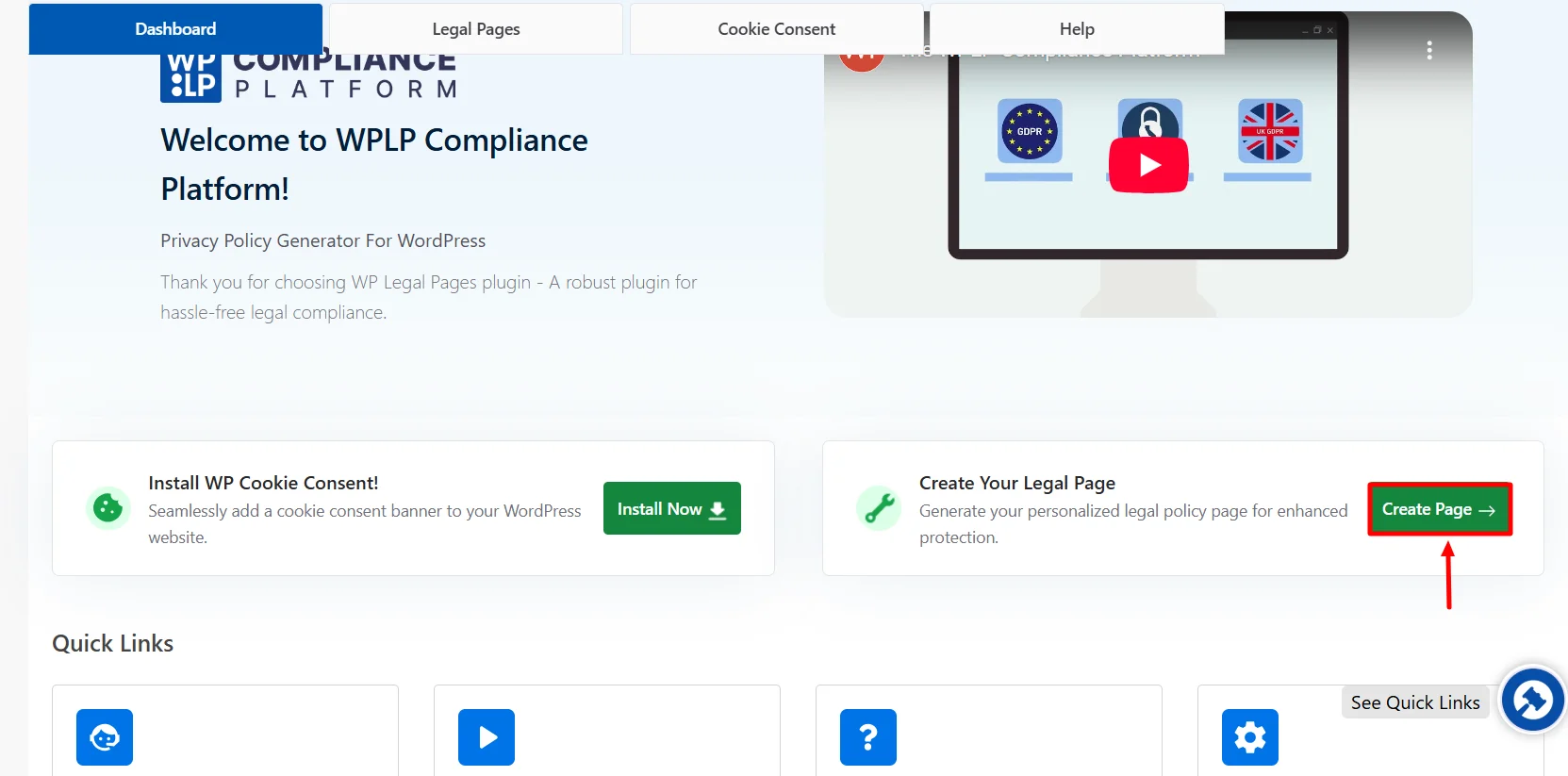
You will be taken to the guided wizard, so scroll down and click on Pro Affiliate Disclosure template.
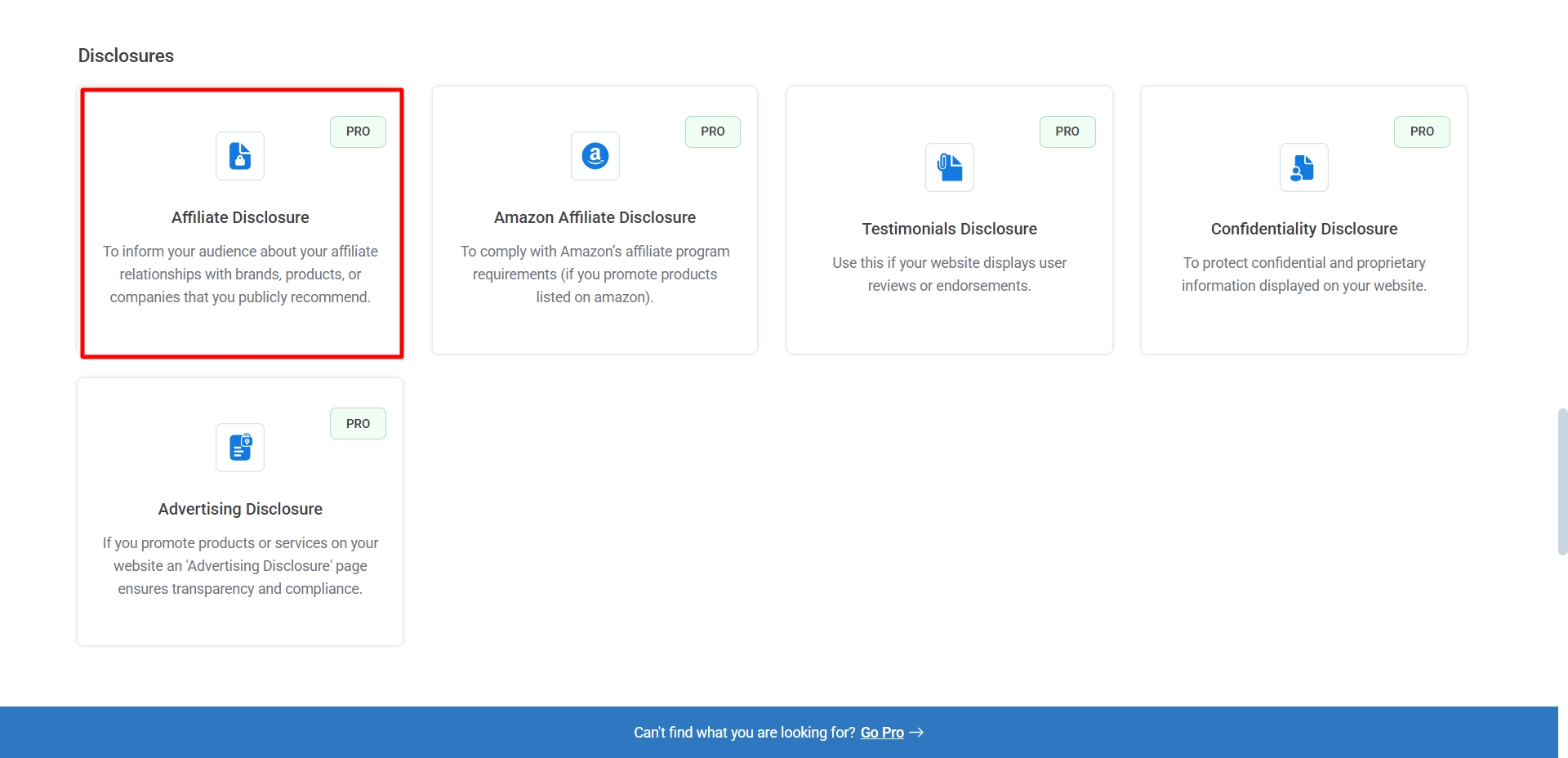
After clicking on the Affiliate Disclosure Pro template, it will ask you to upgrade to WP Legal Pages Pro. So, to upgrade and unlock the pro templates, one of which is Affiliate Disclosure, click on “Unlock 25+ Legal Template”.
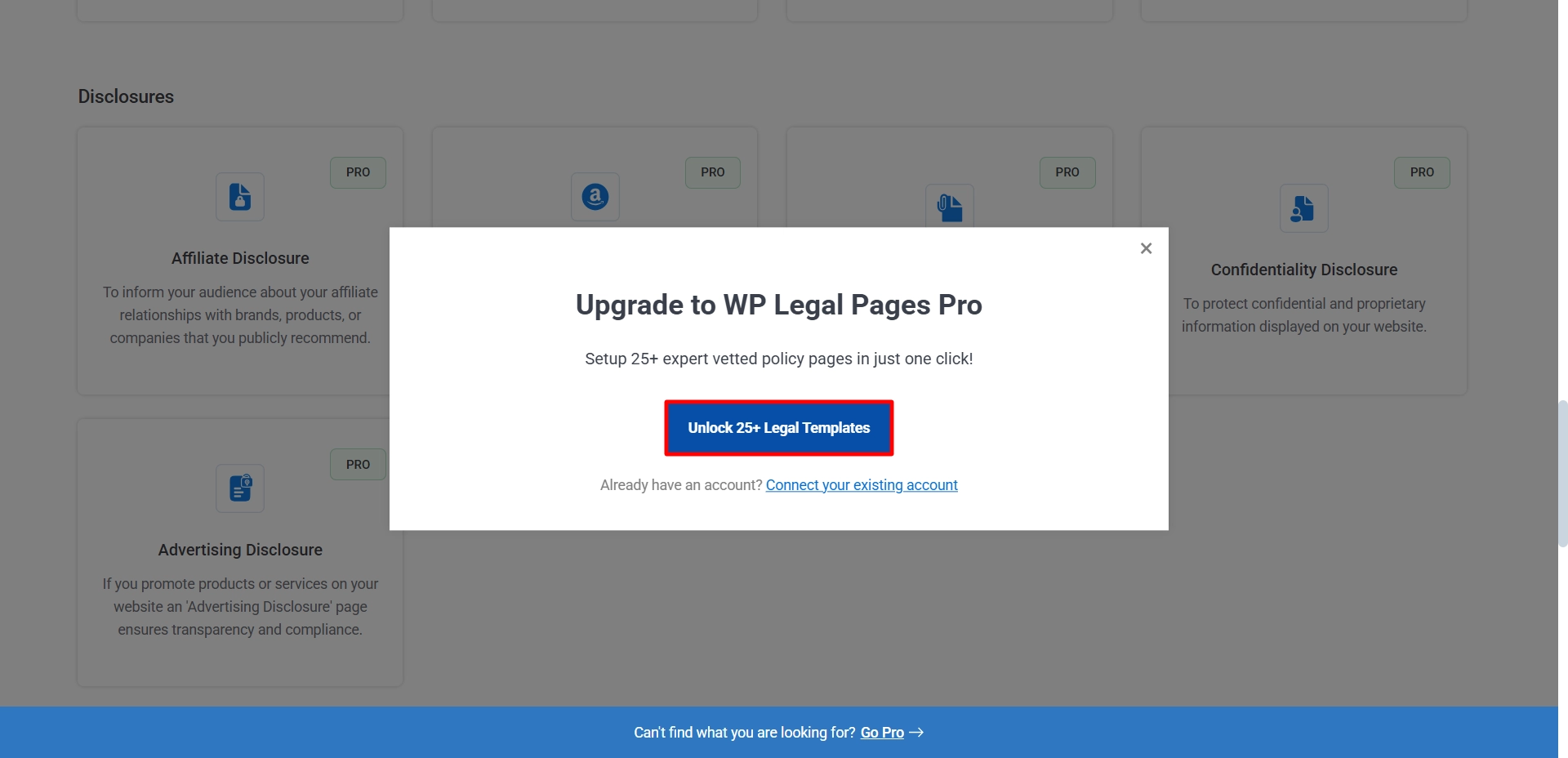
You will land on the pricing page, go with your preferred plan, and click on Buy Now.
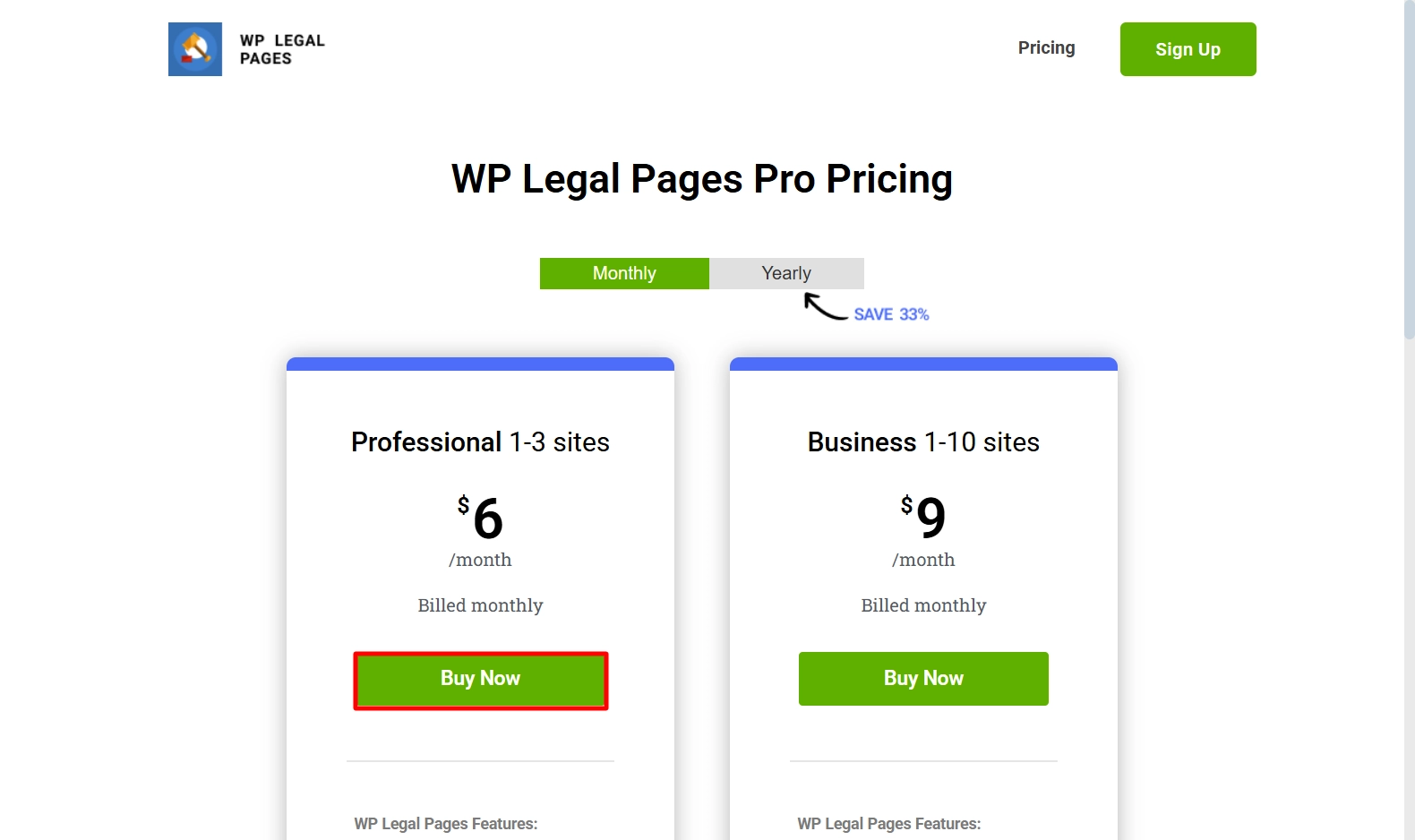
Fill in the personal details and you can apply a coupon code if you have any.
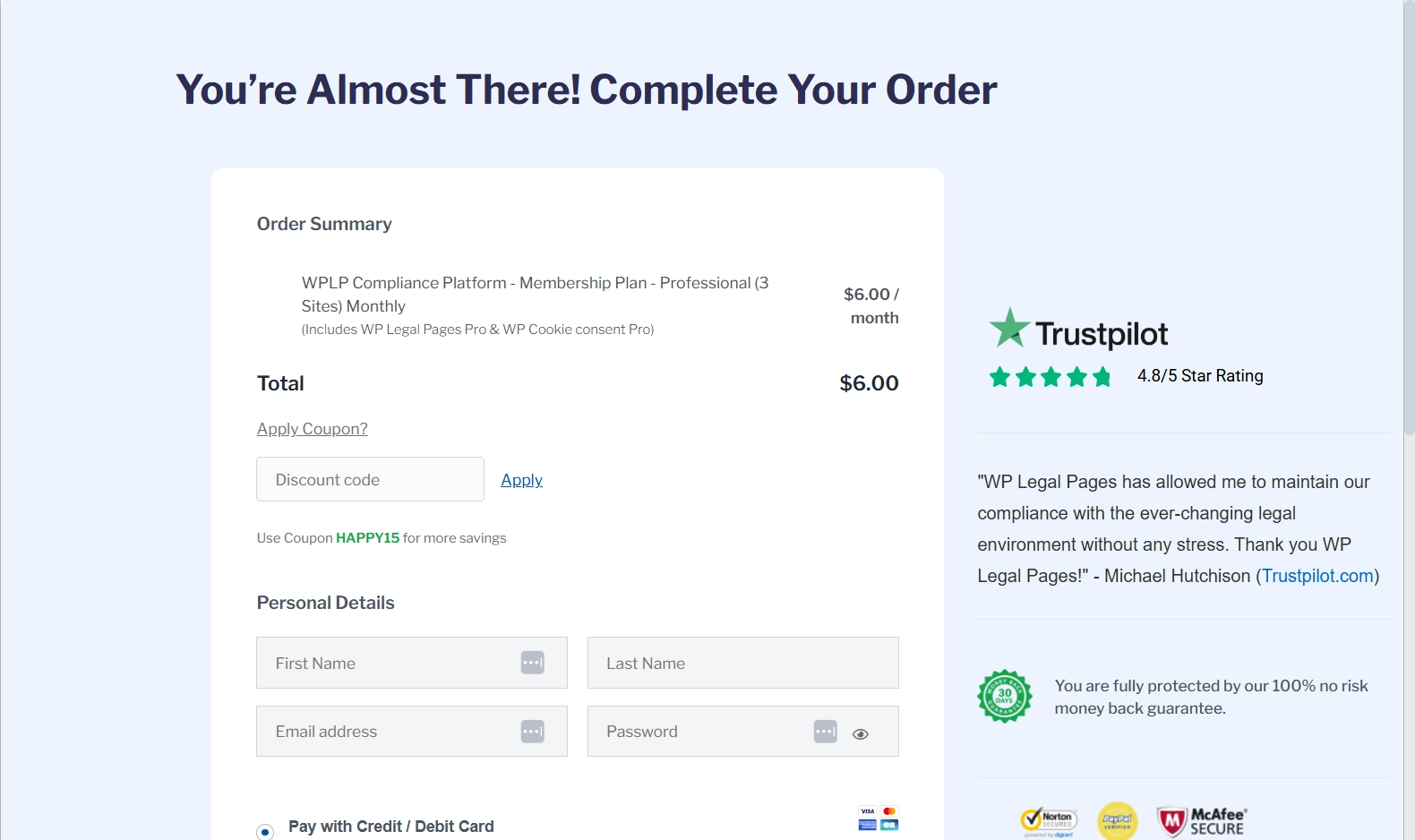
After filling in the details, click on the Submit button.
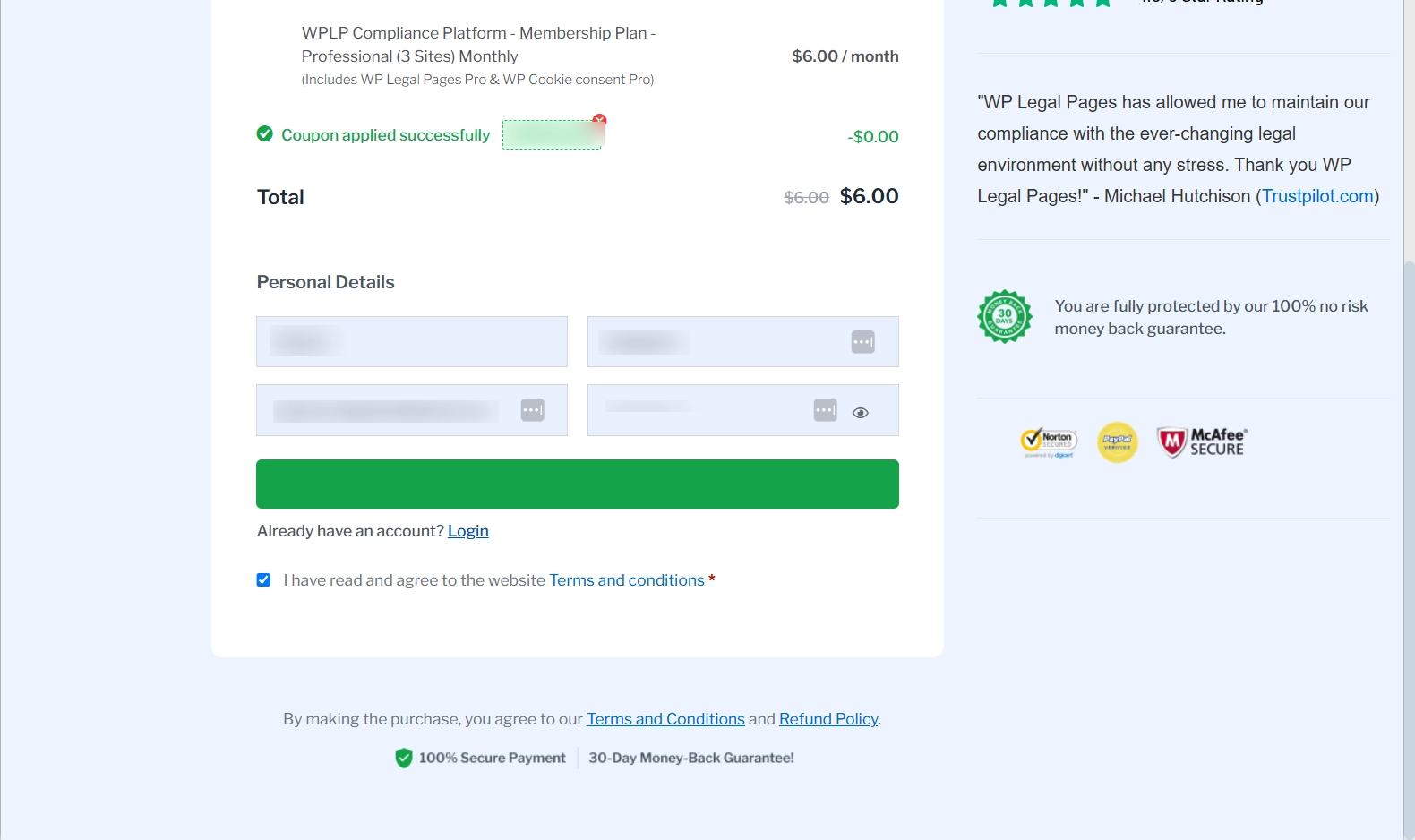
After purchasing, you can click the Resume Template button to go back to the Affiliate Disclosure template.
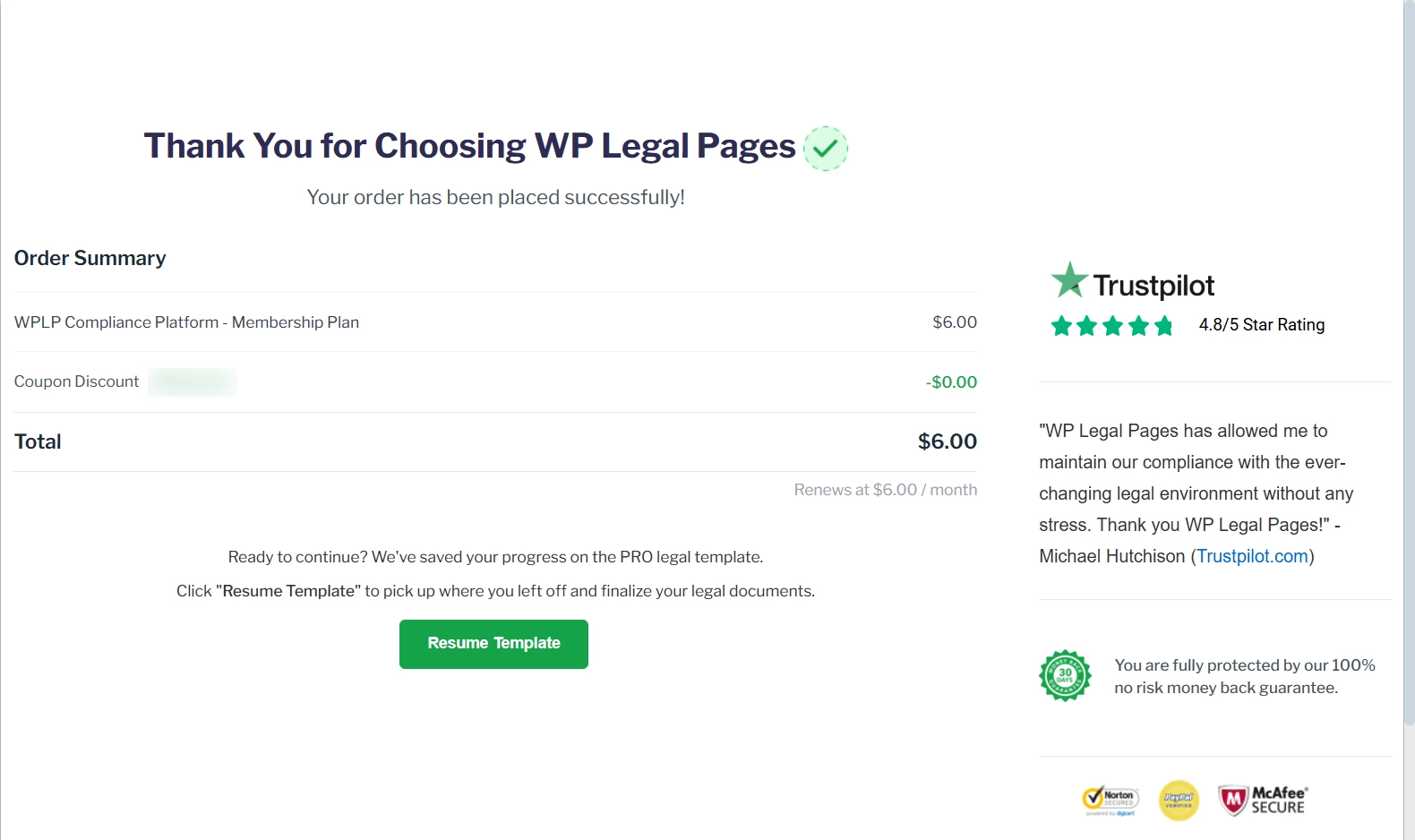
Step 4: Creating an Affiliate Disclosure Document
Fill the essential details and click on Next button.
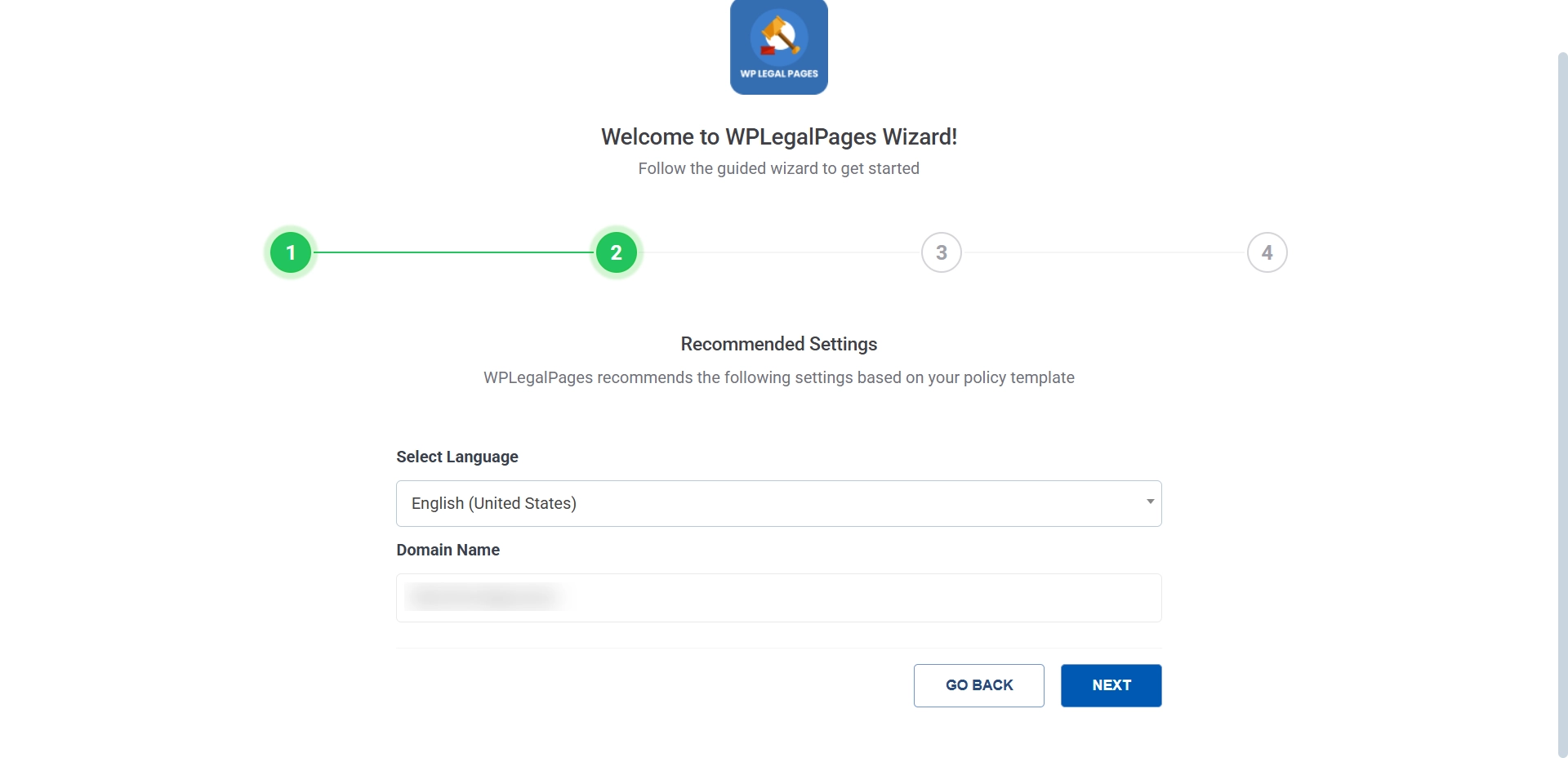
Now you will come across the template preview, you can edit it by clicking Create and Edit.
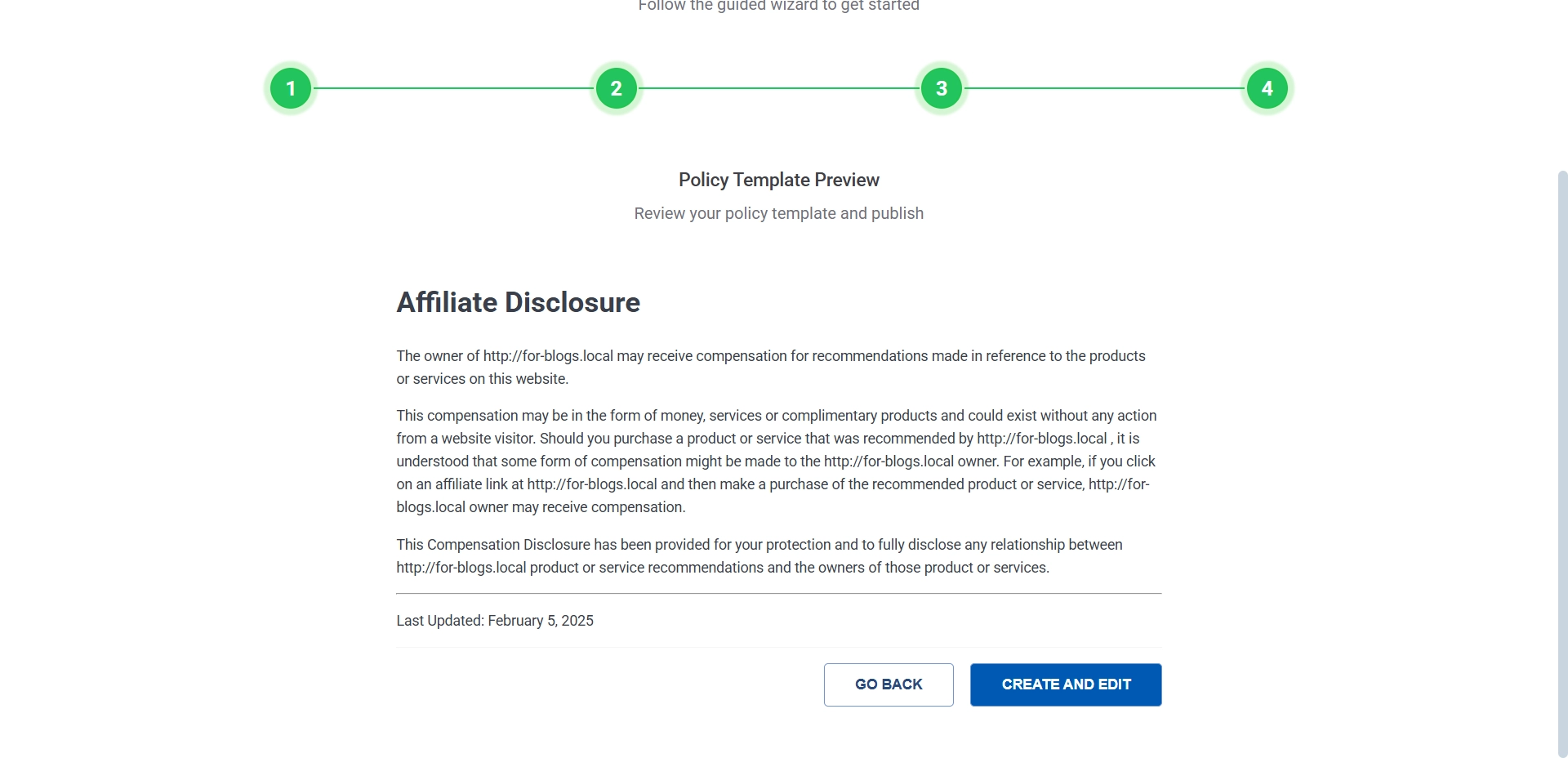
You can edit the disclosure template if you want, according to your need, and then click on the Publish button.
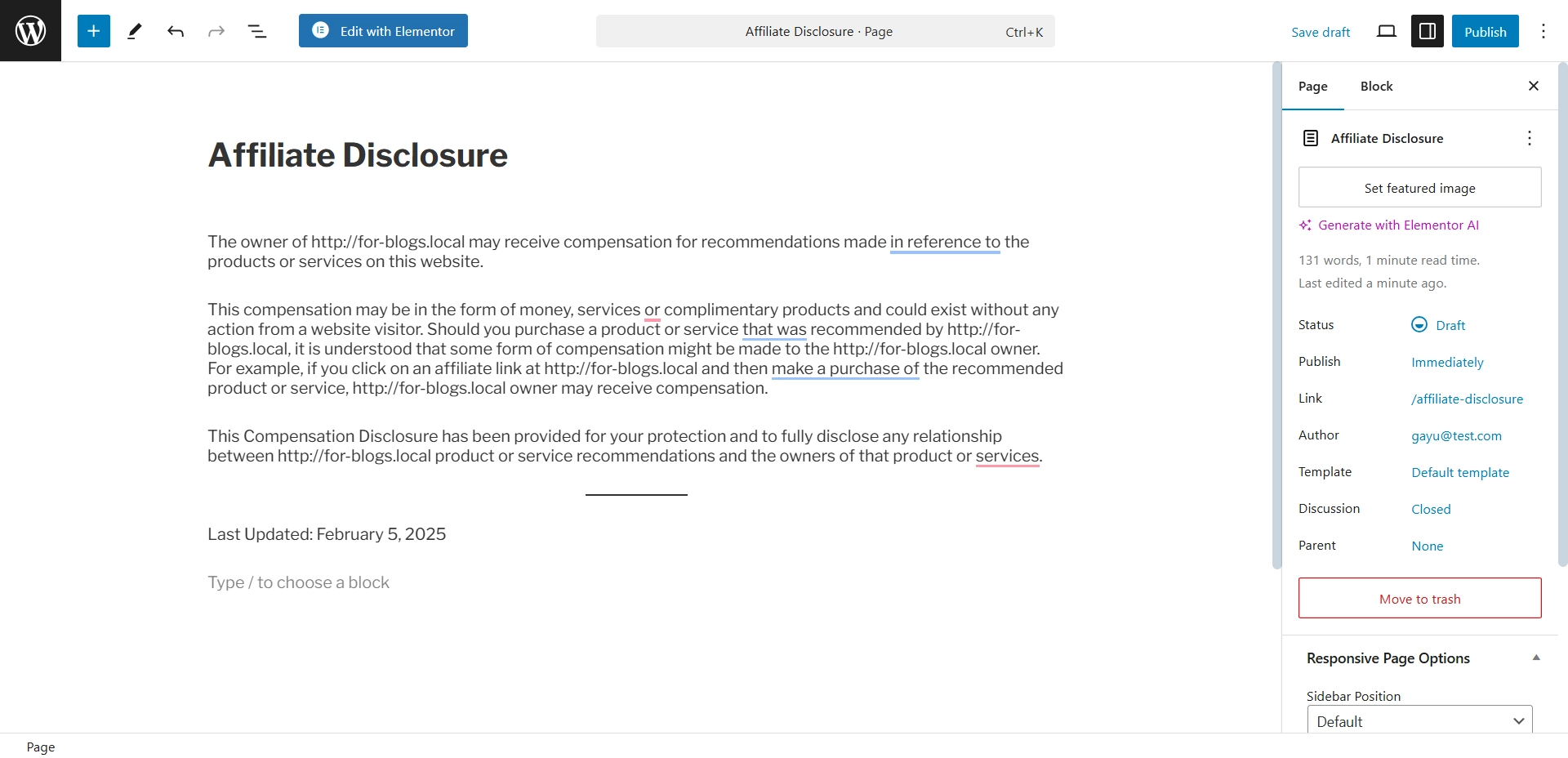
There you go; you have successfully created an Affiliate Disclosure for your website.
Best Places to Add Website Disclosures
Disclosures should be easy to find and visible right away. Use larger font sizes, different colors, or special placements to make them stand out. Place them near areas that catch attention, like the reviews section or endorsements on your site.
Don’t limit disclosures to just one page; they should appear on every page with your affiliate links and branded content.
Disclosures should be positioned so that users do not have to scroll down to see them. They should be among the first things a user notices when visiting your site.
Disclosures inform your audience about any potential biases due to your website’s affiliations with other parties. This information should not be hidden, as today’s websites need to be transparent with their users.
Disclosures provide important information for your online consumers. They also help you build a more honest and trustworthy relationship with your clients.
The best place to add a website disclouser is website footer, pop-ups, or relevant pages.
Let us take a look at how we can add the link to the footer of the website.
Once you are in the settings page of WP Legal pages plugin, click on the Compliance tab.
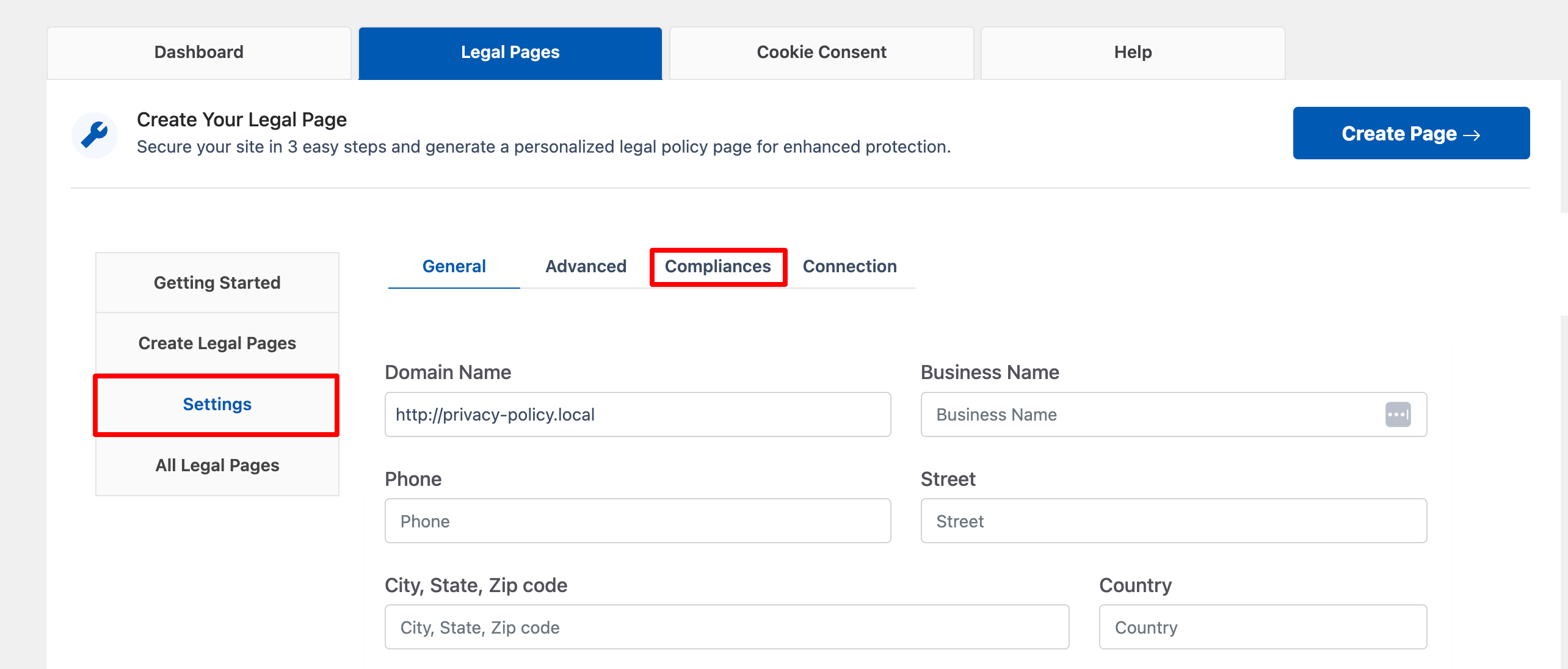
To access the compliance settings, go to the Add Legal Pages Link to the Footer section and click the Configuration button.
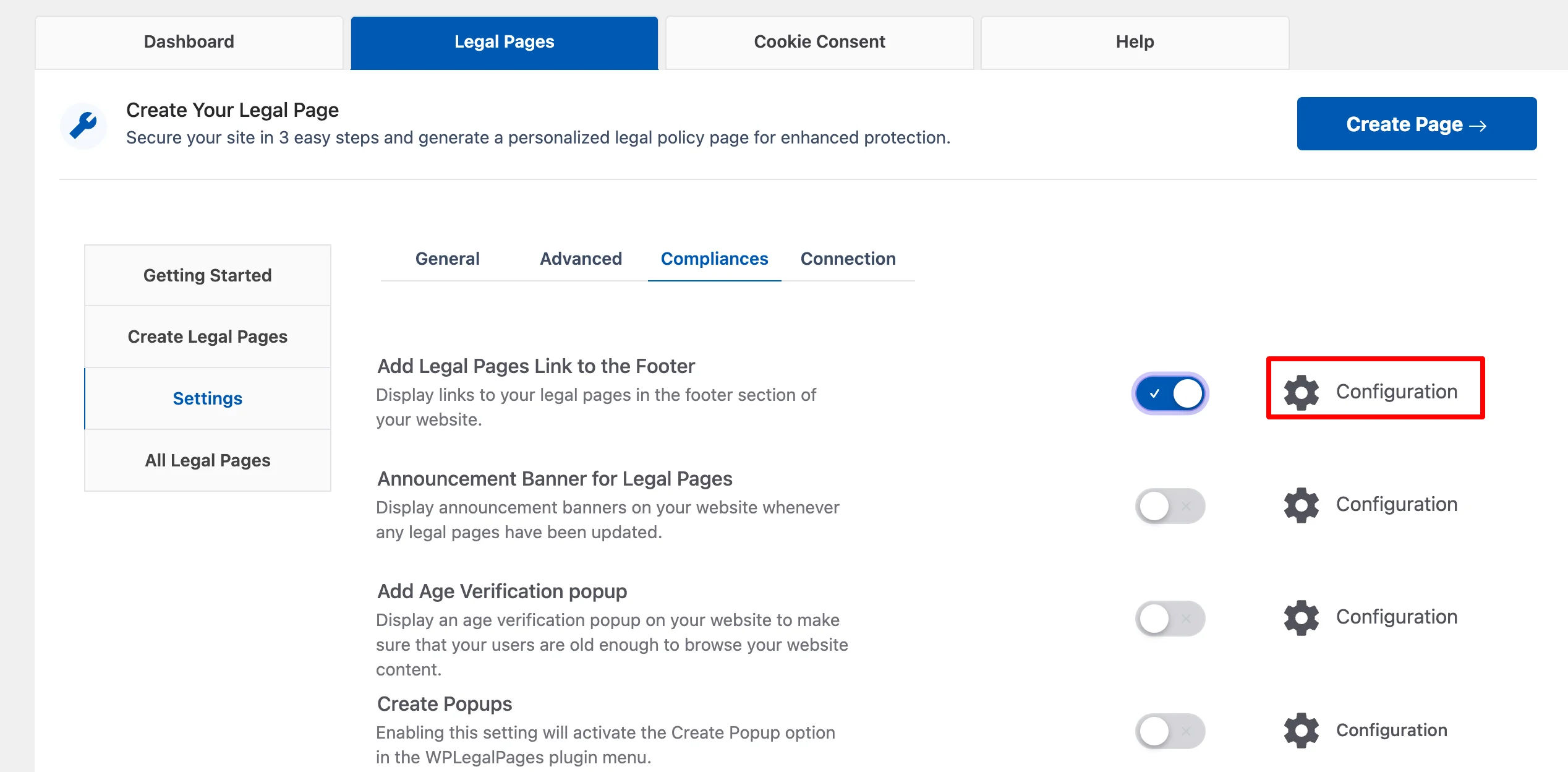
Once you are in the configuration tab, click on the drop-down box of Legal Pages and select the pages that need to be added to the footer. here I will select Privacy Policy and Affiliate Disclouser documents.
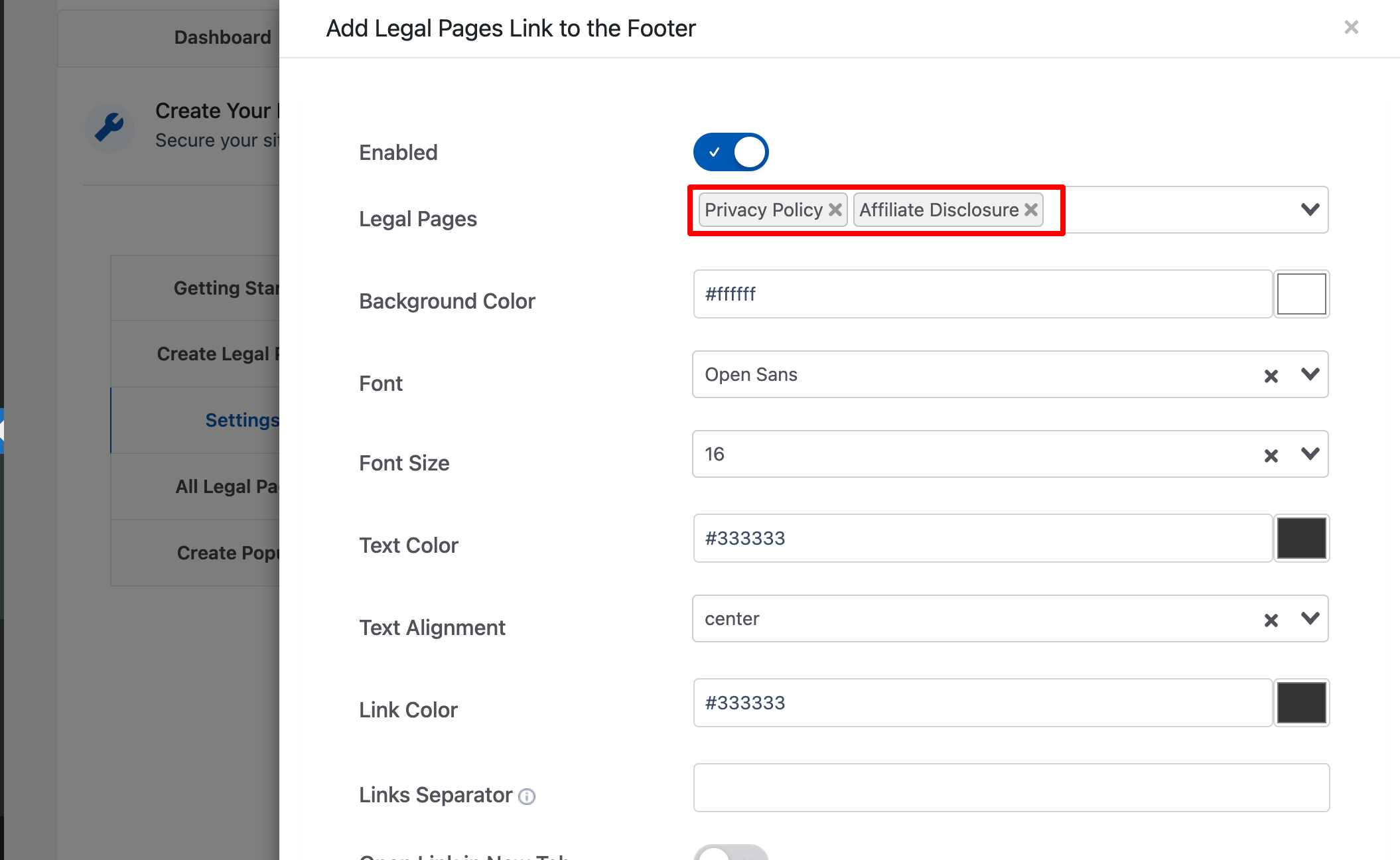
You can also change the order of the links using the Links Order feature.
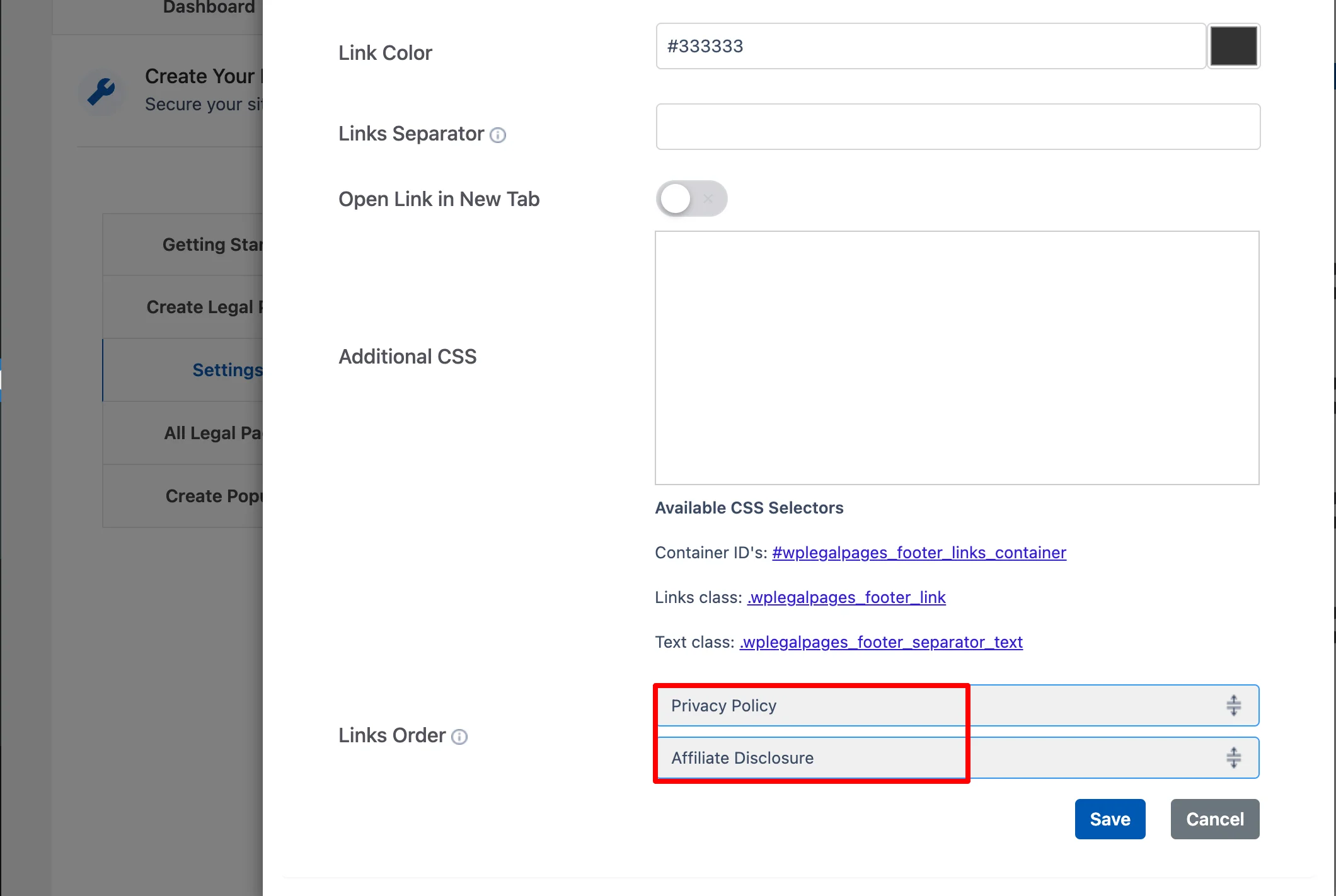
Finally, click on the Save button to save the changes.
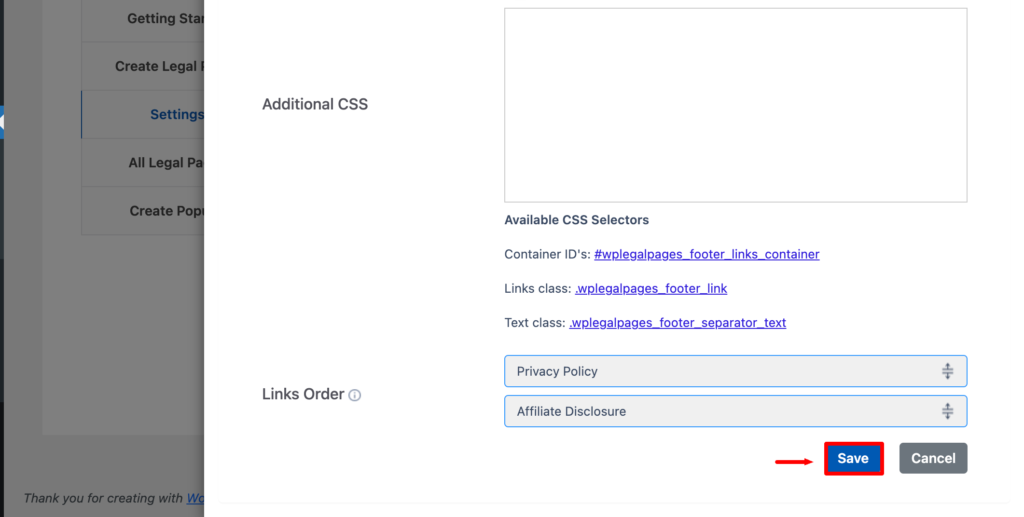
FAQ
A legal disclosure on a website is an official statement that provides important information about how the site operates, what its responsibilities are, and what users can expect. This transparency helps the site meet legal requirements.
1. Installing WP Legal Pages Plugin
2. Configuring WP Legal Pages Plugin
3. Creating a Pro Account in WP Legal Pages
4. Select a template
5. Follow the guided wizard and fill in the basic details
6. Preview the pre-made disclosure template and make changes if you need some.
7. After editing click on publish button.
1. Medical or Legal Services Disclosure
2. Third-Party Relationships Disclosure
3. Affiliate Links Disclosure
4. Advertisements Disclosure
5. Testimonial Disclosure
6. Confidentiality Disclosure
Conclusion
As users and regulators scrutinize online interactions more closely, clear legal disclosures can help make your site more trustworthy and protect your business from legal problems.
WP Legal Pages plugin make it easy to create detailed disclosure documents tailored to your needs. With over thirty-five ready-made templates available, you can quickly create disclosures that cover affiliate links, advertising practices, and other important information.
This proactive approach can build user trust in your brand, which can help your online efforts succeed.
If you like this article, you might also like:
- How to Create a WordPress Privacy Policy for Your Website
- How to Create a Privacy Policy For Landing Pages
- What is Privacy Statement and How to Create One?
Need help generating a website disclosure? Try the WPLP Compliance Platform to create FTC-compliant disclosures in minutes!”
